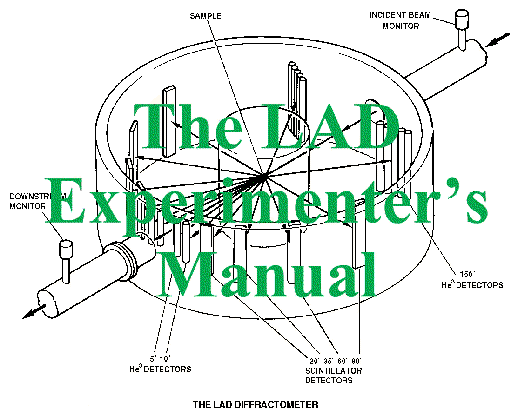
| 2.2 Description of LAD |
![]()
LAD is a time-of-flight neutron
diffractometer, optimised for the study of amorphous solids and
liquids. The detector banks are positioned in the horizontal
plane at seven different scattering angles which range from 5°
to 150°. The structure factor S(Q) can thus be measured over a wide range
of momentum transfer Q, which enables information of high real-space
resolution to be extracted. The wide range of angles allows
measurements to be made successfully for samples containing
elements with nuclear resonances. The detector arrangement on the
two sides of the instrument is the same and thus the 90° banks
enable S(Q) for a planar sample mounted at 45° to the incident
beam to be determined simultaneously for scattering vector Q parallel and perpendicular to the plane
of the sample.The backward angle detector banks have a high Q-resolution which can be of particular
advantage when studying amorphous samples of uncertain quality
(i.e. small Bragg peaks can be easily discernible). A
transmission monitor enables the wavelength-dependent total
cross-section s(l) of the
sample to be studied simultaneously with the differential
cross-section ![]() . The instrument includes a large amount of shielding
between detectors, thus minimising backgrounds from sample
environment equipment such as furnaces.
. The instrument includes a large amount of shielding
between detectors, thus minimising backgrounds from sample
environment equipment such as furnaces.
Figure 1 shows the detector arrangement on LAD. A high quality glossy A4 copy of this figure (suitable for inclusion in a thesis for example) may be obtained on request from A.C.Hannon.
Figure 1b is a new colour picture of LAD.
Figure 2 and Figure 3 show results obtained on LAD for GeO2 glass [3].
The high maximum value of Q (50Å-1) of the measured distinct scattering i(Q) (Figure 2) shows the large Q-range which LAD can cover for a sample with well-defined short range order. This leads to the high real-space resolution apparent in the total correlation function (Figure 3).
![]()
![]()
Last Updated 15 Aug 2007